UNSW student finalists in national design awards
A shallow diving kit, an inflatable life-saving device and a bushfire early detection system are three UNSW student innovations recognised in a national design competition.
A shallow diving kit, an inflatable life-saving device and a bushfire early detection system are three UNSW student innovations recognised in a national design competition.

A mission to improve the experience of being immersed in the underwater world inspired Edric Verbeek-Martin to create Freedive. The shallow diving kit enables divers to descend to six metres and stay there for over an hour without surfacing.
The UNSW industrial design student’s creation is a finalist in the Hills Young Australian Design Awards, a new national design competition for young Australian designers, engineers, innovators and entrepreneurs.
Mr Verbeek-Martin said the expense, training and heavy equipment required for SCUBA diving was a significant barrier to the sport.
“Freedive bridges the gap between SCUBA diving and snorkelling and allows divers to stay underwater at a depth that reduces the risk of decompression illness, but also without cumbersome scuba gear or to be tethered to a boat,” said Mr Verbeek-Martin.
The kit comprises a floating bucket-sized air compressor unit which attaches to a diver’s full face mask via a hose.
“The hose effectively limits the depth a person can go to, making it safer for people who have not done the training needed for SCUBA diving” said Mr Verbeek-Martin.

UNSW industrial design student Edric Verbeek-Martin
Mr Verbeek-Martin joins 16 other finalists in the competition, including fellow UNSW industrial design student Max Glanville who has created Fire Front.
The early warning system detects bushfires using a thermal imaging camera and ultrasonic wind detectors. The technology allows early detection of extreme heat and flames, while monitoring temperature, wind speed and direction.
The prototype, which is aimed at the residential market, has a detector as well as a home module linking the home and an app for mobile connectivity.
Mr Glanville believes Fire Front can help evacuate people 50 per cent faster as it can detect fires quicker than any other solution on the market.
“This is something I have been passionate about for a long time and my dream would be to get this product funded and into homes.’’

Fire Front
A third finalist Raymond Tinyow developed Nautilus, a self-righting life-jacket with an integrated inflatable life raft system. The Nautilus provides immediate short term protection to survivors of boat accidents protecting them from the elements, and ultimately drowning.
“70 per cent of cold water deaths happen within 10 minutes, even with a lifejacket,” Tinyow said. “That was when I saw the opportunity for a solution - I needed an immediate, effective way to get people up and out of the water.”
Both the life-jacket and inflatable raft be detached from each other making rescues easier.
All three designers are looking for funding to develop their products and get them on the market within the next two years.
UNSW Built Environment Industrial Design Program Director Stephen Ward said the strong showing by UNSW’s industrial design alumni in the awards was no surprise.
“Our graduates are designing ambitious products that solve real-world problems,” Mr Ward said.
“Edric, Max and Raymond are just three of the new generation of Australian industrial designers coming through UNSW’s Bachelor of Industrial Design program.
“It’s all the more remarkable that students can finish our program with achievements like these already in their portfolio.”
The products were developed last year in the student’s final year of the four year UNSW Bachelor program.
The winners will be announced on Friday, 29 May at the Dockside Pavilion in Sydney.
Mr Glanville’s entry in the awards was featured in The Australian newspaper earlier this week.